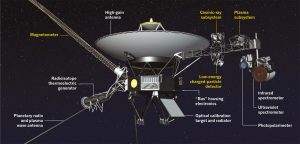Today is the 40th anniversary of the launch of the Voyager 1 spacecraft. On September the fifth in 1997 a Titan 3-C rocket took off from Kennedy Space Center carrying a 773 kilo spacecraft that has completely changed the way we see our solar system and even now is exploring the space between the stars themselves. How many things do you know of that are still working after 40 years. The picture below shows Voyager and the various parts of the spacecraft.

The original concept for the Voyager missions was to be a ‘Grand Tour’ of the outer solar system with flybys of four planets Jupiter, Saturn, Uranus and Neptune. Indeed, the Voyager 2 spacecraft did succeed in visiting them all giving us our first close up view of Uranus and Neptune.
The discoveries made by these two robot explorers are too numerous to mention. I can only mention a few: Jupiter’s Rings, volcanoes on Io, the ice covering on Europa, shepherd moons in Saturn’s rings, the dense hydrocarbon atmosphere of Titan, the broken moon Miranda of Uranus and the great black spot on Neptune. Before Voyager all of these places were at best hazy smudges in a telescope, it was Voyage that turned them into worlds for us. The mosaic picture below shows some of the images taken by the Voyager spacecraft.

Because their mission was planned to take them on a journey so far from the Sun the Voyagers could not be powered by solar cells as most spacecraft are. Instead, each of the two probes carries three Radioisotope-Thermoelectric-Generators (RTGs). RTGs are basically a rod of radioactive material surrounded by thermocouples that convert the heat into electricity. the three generators combined produced a combined 470 watts of power at launch and even today after 40 years they are still generating about half that amount. That is still enough power to enable the Voyager probes to remain in contact with Earth although most of the probe’s instruments, such as the cameras, have been turned off to conserve power. Only the magnetometer and the low and high energy particle detectors continue to operate, continue to give us information about the space through which Voyager still journeys.
Today Voyager 1 has entered interstellar space, the first object made by mankind to do so. When the Voyagers were launched 40 years ago no one had any idea what the edge of the solar system would be like let alone where it might be. It was Voyager 1 who showed how the solar wind, pushing out from the Sun, comes to a pause known as the heliopause. Beyond that the low energy particles from the Sun disappear while the magnetic field shifts to that of the Milky Way.
Voyager 1 entered interstellar space in August of 2012 and Voyager 2 will soon join it. NASA estimates that the power sources on the spacecraft will allow them to remain in contact with Earth until sometime around 2030.
When that contact is lost the long mission of these explorers will finally be over, but only for human beings! You see the scientists and engineers who built Voyager knew that their creation could travel between the stars for thousands if not millions of years and there was the remote but still exciting possibility that one of the Voyagers might someday be found by non-human intelligences.
So the men who built Voyager included a greeting to any aliens that might find it. A golden record was stored away in the Voyager spacecraft. This record contained some of the sounds of Earth, music and greetings, along with images of life on Earth. The cover protecting the record has instructions for playing the record and even a stylus to be used in the playback. It is possible that the messages sent on Voyager may one day be the only record of our ever existing!
In 40,000 years Voyager 1 will pass about 1.6 light years from the star Gliese 445 while at the same time Voyager 2 will pass about 1.7 light years away from the star Ross 248 (both are red dwarf type stars). Even then the Voyagers will continue on and where their journey will end no one can say.
As of this morning Voyager 1 was 20,884,724,316 kilometers from the Sun and getting 16.995 kilometers further every second. Voyager 2 was 17,178,385,861 from the Sun and moving at a velocity of 15.374 kps.
If you’d like to know more about the Voyager spacecraft NASA has two websites. The first deals with the entire voyager mission while the second is for ‘Voyager the Interstellar Mission’. Click on the links below to be taken to those sites.
https://www.nasa.gov/mission_pages/voyager/index.html
https://voyager.jpl.nasa.gov/
